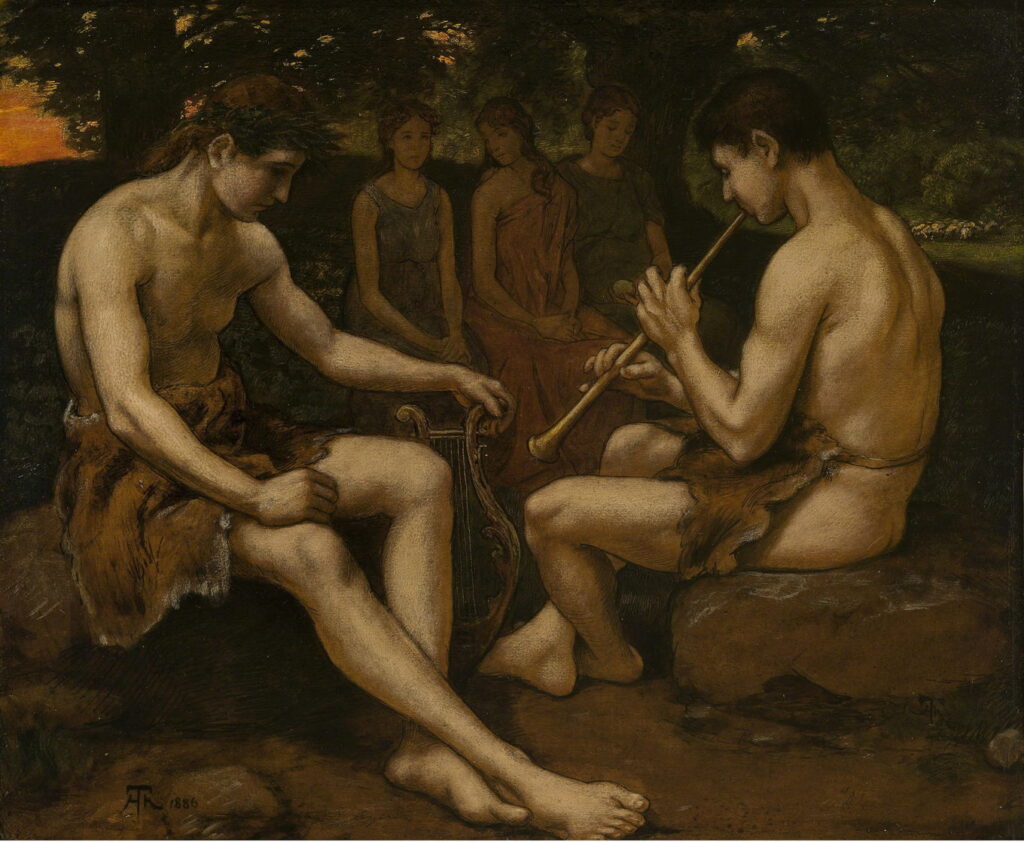Changing Paintings: 27 The music contest

Following the relatively light relief of the tale of Lycian peasants turned into frogs, Ovid’s Metamorphoses briefly covers the horrific story of Marsyas, adding an odd intercalation about Pelops. Ovid links to this story through Latona: the twins born to her in Lycia were Diana and Apollo, and this is about the divine retribution of the latter.
Marsyas was a satyr who became an outstanding player of the aulos, a double-piped reed instrument termed here Minerva’s flute, although not a flute at all. This refers to the myth of Minerva’s ‘invention’ and pioneering of the instrument.
Elihu Vedder (1836–1923), Young Marsyas (Marsyas Enchanting the Hares) (1878), oil on canvas, dimensions not known, Private collection. The Athenaeum.
In 1877, Elihu Vedder had been thinking about the myth of Marsyas. Rather than show the contest with Apollo or its grim consequence, Vedder reasoned that Marsyas must have proved his skill with the aulos before the challenge arose. His conclusion was that the satyr might have been charming hares, leading him to paint Young Marsyas or Marsyas Enchanting the Hares (1878). Vedder shows a young Marsyas in the snows of the New England winter, surrounded by the enchanted hares.
Marsyas and Apollo took part in a contest against one another to determine who was the better player. Judged by the Muses, Apollo inevitably won, his prize being to treat the loser in any way that he wished. Apollo chose to flay Marsyas alive, inflicting the most gruesome, painful, and horrific death that he could have devised. Ovid provides a short but graphic description of the satyr’s body becoming one huge wound, and the tears of all around, particularly other satyrs and fauns, whose weeping created a new river in Phrygia, named after Marsyas.
Jacopo Tintoretto (c 1518-1594), Apollo and Marsyas (1541-42) (E&I 15), oil on panel, dimensions not known, Galleria Estense, Modena, Italy. Image by Sailko, via Wikimedia Commons.
Jacopo Tintoretto’s Apollo and Marsyas from 1541-42 shows the contest, but leaves its outcome to the viewer’s imagination. Apollo is on the left, holding an anachronistic violin, as Marsyas on the right plays his pipe.
Jacopo Tintoretto (c 1518-1594), Contest of Apollo and Marsyas (1544-45) (E&I 34), oil on canvas, 139.7 x 240.3 cm, Wadsworth Athenaeum Museum of Art, Hartford, CT. Wikimedia Commons.
From that simple motif, Tintoretto developed his later Contest of Apollo and Marsyas in 1544-45. This reiterates his previous motif at the left, with the addition of a small audience consisting of a token Grace, as judge, and three men. This was commissioned in 1544 by Pietro Aretino (1492-1556), a major literary figure of the time and close friend of Tintoretto’s rival Titian. Aretino was a successful satirist and early writer of pornography, who later became a successful blackmailer.
Cornelius van Poelenburgh (1594/95–1667), The Musical Contest between Apollo and Marsyas (1630), oil on panel, 56 x 77 cm, Hallwylska museet, Stockholm, Sweden. Wikimedia Commons.
Cornelius van Poelenburgh takes us into the myth itself, showing The Musical Contest between Apollo and Marsyas (1630). Marsyas is to the right of centre, with two other satyrs behind him. Apollo, wearing a crown of laurels both as his attribute and possibly an indication of his victory in the contest, is holding forth from a rocky throne to the right. At the left are the Muses, the jury for the contest, with another couple of satyrs. There’s also a mystery couple, seen walking away in the distance to the left of Marsyas’ right leg.
Giovanni Battista Tiepolo (1696–1770), Apollo and Marsyas (1720-22), oil on canvas, 100 x 135 cm, Gallerie dell’Accademia, Venice. Wikimedia Commons.
Tiepolo’s Apollo and Marsyas (1720-22) also takes the contest as its theme. It’s easy here to mistake the figure sat on the rock throne as being Apollo, but he’s actually the youth at the left, bearing his lyre, wearing a wreath of laurel, and given a gentle divine halo. Thus the figure apparently wearing a gold crown sat in a dominant position must be Marsyas, clutching a flute of sorts in his right hand. To the right are some of the Muses, one of whom covers her eyes in despair. She knows what Apollo’s pointing arm is about to inflict on the usurper Marsyas.
Hans Thoma (1839–1924), Apollo and Marsyas (1886), oil on panel, 45 × 55 cm, location not known. Wikimedia Commons.
Apollo and Marsyas (1886) is Hans Thoma’s depiction of the contest, with Marsyas playing, and only three of the Muses in the background. Although not a strongly narrative painting, as it makes no reference to the outcome, this was probably more appreciated by contemporary viewers.
Titian (Tiziano Vecelli) (1490–1576), The Flaying of Marsyas (c 1570-1576), oil on canvas, 212 × 207 cm, Arcidiecézní muzeum Kroměříž, Olomouc Museum of Art, Kroměříž, The Czech Republic. Wikimedia Commons.
By far the most famous painting of the flaying itself is one of Titian’s last great works: The Flaying of Marsyas from about 1570-1576. The satyr has been strung up by his legs from a tree, his arms also bound, and is now having his skin and hide cut off, Apollo kneeling at the left with his blade at Marsyas’ chest. Standing above the god is one of the Muses, playing her string instrument and gazing upwards. Near her left hand are Pan pipes rather than an aulos, strung from the tree next to the satyr’s body. At the right, another satyr has brought a pail of water. Others gaze on in dismay at the grisly scene.
Agnolo Bronzino (Agnolo di Cosimo) (1503–1572), The Flaying of Marsyas (1531-32), oil on canvas, transferred from panel, 48 × 119 cm, Hermitage Museum Государственный Эрмитаж, Saint Petersburg, Russia. Wikimedia Commons.
Bronzino’s The Flaying of Marsyas (1531-32) summarises the tragedy in its multiplex narrative. At the right, the contest is taking place, with a very human Marsyas playing a wind instrument resembling a clarinet, which is at least a reed instrument like the aulos.
In the left distance, Apollo subdues the defeated Marsyas and binds him. Supervising this is a goddess, who appears to be Minerva, with a shield and spear, who first ‘invented’ and played the aulos. In the centre, Apollo is flaying the satyr, who is here neither bound nor suspended from a tree. The figure in the left foreground may be Olympus, who is expressing his grief.
The subject of mourning leads Ovid back to mention Amphion and his wife Niobe, who was mourned by Pelops. The latter was subject of a well-known myth in which Tantalus, his father, killed him and dismembered the body, then served it up to the gods to test their omniscience. Ceres, still distracted by the rape of Proserpine, ate Pelops’ shoulder. When the gods reconstituted Pelops and brought him back to life, a piece of ivory was fashioned into a replacement shoulder for him. Mercifully, I’m not aware of any painting by a major artist that attempts to depict this story.



